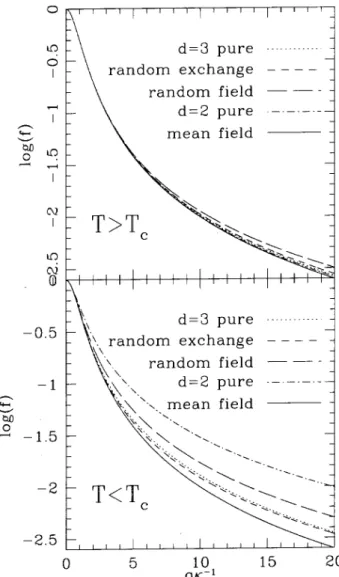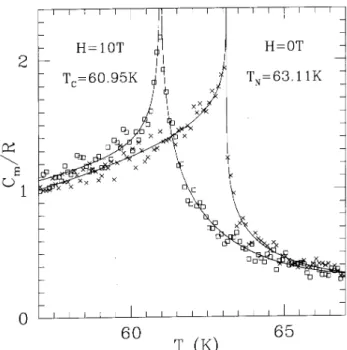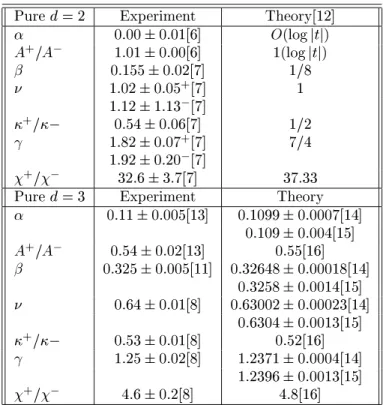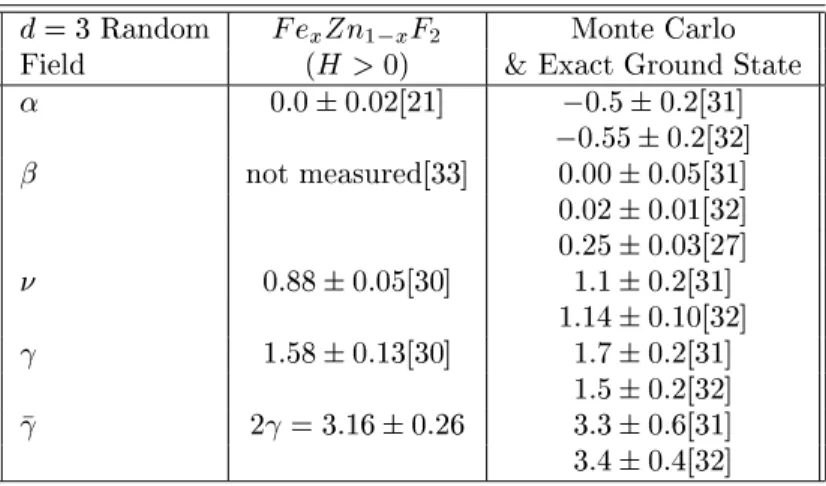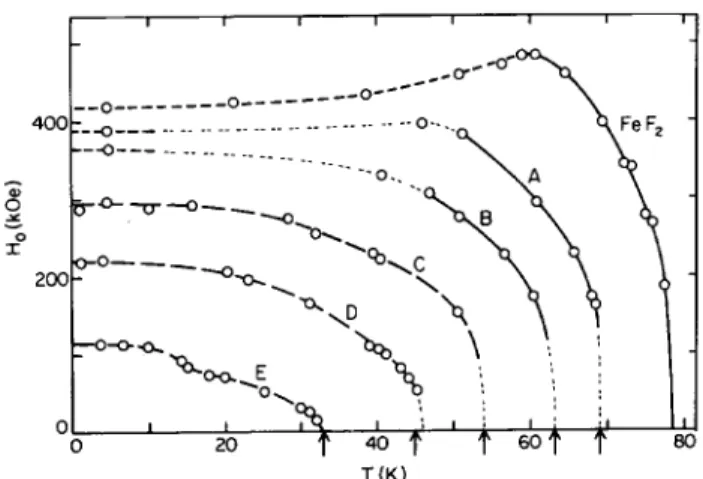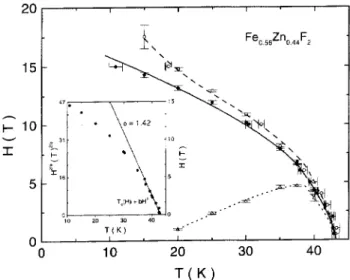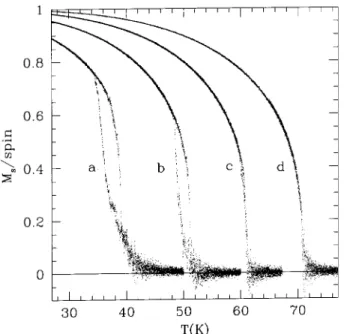Experimental Charaterization of the Ising Model
in Disordered Antiferromagnets
D. P.Belanger
Department ofPhysis,UniversityofCalifornia,Santa Cruz,CA95064USA
Reeivedon5August,2000
Theurrent status of experiments onthe d = 2 and d = 3 random-exhange and random-eld
Isingmodels,asrealizedindiluteanisotropiantiferromagnets,isdisussed. Twoareasofurrent
investigationareemphasized. Ford=3,thelargerandomeldlimitisinvestigatedandequilibrium
ritialbehaviorisharaterizedathighmagnetionentrations.
I Introdution
The Ising model is one of the most studied and
ba-si models for phase transitions. In this artile, the
urrent status of experimental studies haraterizing
two lassi models of seond-order phase transitions
in short-range interation systems in the presene of
quenhed disorder, the random-exhange Ising model
(REIM) and the random-eld Ising model (RFIM), is
presented. Thedisussiononentratesonexperiments
in dilute, insulating, anisotropiantiferromagnets,the
systemsthathaveyieldedthebestunderstooddatafor
these twomodels. TheREIM is realized in zero
mag-netieldandtheRFIMwithaeldappliedalongthe
spin-orderingdiretion.
TheREIM is rather well haraterized
experimen-tally, theoretially and throughomputersimulations.
Thed=2RFIMis fairly wellharaterized, although
the saling behavior of sattering near the destroyed
phasetransitionisstillbeinginvestigated.
The understanding of the RFIM for d = 3 is not
asomplete,thoughsigniantprogresshasbeenmade
in thepastfewyears, anditis thismodel thatwill be
themain fousofthis short review. Theearly history
of the d=3RFIM wasfraught with ontroversial
in-terpretationsofthedata,aresultofsevere
nonequilib-rium eets. Nevertheless, some experimental groups
realized from the start that underlying the observed,
ompliatedbehaviorisanewkindofphasetransition.
Eorts to haraterizethe new ritial behavior were
thwarted by the severe nonequilibrium eets. These
nonequilibrium eetshavereentlybeenoveromeby
goingtosuÆientlyhighmagnetionentrationanda
ompleteharaterizationoftheuniversald=3RFIM
ritial behavioris possible and underway. The most
reent statiritial behavior will be ompared to
re-sultsfromomputersimulationsandtheory.
Inaddition to these low-eld behaviors, muh has
An overview will be given of the phase diagram and
thedierentbehaviorsobserved.
Experiments have been performed on REIM and
RFIM systems for more than two deades. Sine the
experiments performed some time ago have been
re-viewed previously[1℄, they will be inluded here only
asneededtogiveaperspetiveontheurrentphysial
understandingofthemodels.
Theory and simulation results will be inluded as
neededfortheinterpretationoftheexperiments.
Another lassi model of ordering in the presene
of disorder, the spinglass, will be overed in another
review[2℄ in this Ising Colloquium and so will not be
disussed here in detail, although somespin-glass-like
behaviorsdoouratlowmagnetionentrationsand
at highmagnetields.
TableI showsthe mostfrequentlymeasured stati
ritial behaviors assoiated with a phase transition.
Wewillmakereferenetotheuniversalparameters
de-ned inTableI asneeded.
speiheat C=A
jtj
+B
for!0 C=Alnjtj
orderparameter(T <T
) M
s =M
o jtj
utuationorrelationlength =
o jtj
=1=
staggeredsuseptibility
s =
o jtj
disonnetedsuseptibility d
s =
d
o jtj
Table 1. Asymptoti forms for ommonly measured
stati ritialbehaviors. Thesupersript +(-)on the
amplitudes signies T > T
(T < T
). The exponent
values and the amplitude ratios are universal
II Experiments on Pure d = 2
and d = 3 Anisotropi
Anti-ferromagnets
Observations of asymptoti stati ritial behavior in
the pure d = 2 and d = 3 Ising antiferromagnets
are verywelldoumented. Themagneti speiheat
(C
m
)ritialbehaviorhasbeenharaterizedusing
op-tial linear birefringenetehniques[3, 4℄on thed=2
Rb
2 CoF
4
system[5℄andthed=3FeF
2
system[6℄.
The measuredpure Ising ritial exponents and
the amplitude ratios A +
=A are in superb agreement
withverymanytheoretialandsimulationresults. The
birefringenetehniqueispartiularlyusefulandmore
auratethanpulsedspeiheattehniquessineitis
insensitivetothelargephononontributionswhihare
partiularlydiÆultto handleford=2.
Theritialbehaviorofthestaggeredsuseptibility
andorrelationlengthhavebeendeterminedwith
neu-tronsatteringforK
2 CoF
4
[7℄ford=2and inFeF
2 [8℄
ford=3.
In general, the sattering line shapes for the pure
and REIM systems away from the Bragg sattering
pointfollowthesalingbehaviorofthespin-spin
orre-lation funtion
s
(q)=A
2
f(q=) ; (1)
where =(2 ).
Forbothd=2andd=3,thesalingfuntionsused
in dataanalysisareapproximateones[9,10℄thatdier
signiantlyfromthemean-eld(MF)Lorentzian
f(q=)= 1
1+(q=) 2
; (2)
asanbeseeninFig.1wherevarioussalingfuntions
are ompared. The deviation from the Lorentzian is
morepronounedford=2andforT <T
(H)inboth
dimensions.
Theorderparameterritialbehaviorhasbeen
de-terminedusing neutronsattering[7℄inthed=2
om-pounds. TheMossbauertehnique[11℄ was usedin the
study ofthed=3system.
Theresults for thepure Ising model in d =2and
d=3aresummarizedin Table2. Notethatthe
Rush-brookesalingrelation
2++2 (3)
is satised as an equality for both ases. Inluded in
Table2aretheresultsfrom afewtheoretialand
sim-ulationstudies. Noattemptismadetoreviewthevast
literatureonthepureIsingmodels.
Figure1. Aomparisonofthelogarithmofthesaling
fun-tionsf(q=)versusq=fordierentmodels(SeeEq.1). The
pureasesarefromapproximateexpressionsfromnumerial
studies[9 ,10 ℄. TheREIMand RFIMare determinedfrom
theexperiments.NotethattheorretionstotheMF
equa-tionarelargestbelowthetransitionandareverysigniant
forthepured=2andrandom-eldd=3ases.
III Random-Exhange
Experi-ments in Dilute d = 2 and
d = 3 Anisotropi
Antiferro-magnets
TheREIM is realizedin dilute, anisotropi insulating
antiferromagnetswhenthesitedilutiondoesnotresult
instronglyfrustratedbonds(whihwouldleadto
spin-glass behavior). Random-exhange phase transitions
areobservedin d=2andd=3systemsandthese
ap-peartobeingoodaordwiththeoryandsimulations.
Thed=2REIMC
m
ritialbehaviorwasobserved
usingthebirefringenetehnique[5℄onthemagnetially
dilute antiferromagnet Rb
2 Co
0:85
Mg F
4
ap-proximatelylogarithmidivergene isompatible with
theoretialpreditions[17,18℄.
Thesatteringritialbehavior[19℄oftheompound
Rb
2 Co
x Mg
1 x F
4
wasanalyzedusingapproximate
sat-tering line shapes[9, 10℄ developedfor the pure d= 2
Ising model. The suessful analysis using these line
shapes suggeststhat theorret line shapeis lose to
thepureone. Thestatiritial behaviorofthed=2
Ising model isquitewellharaterizedby experiments
andtheoryasshowninTable3.
Thed=3REIMissimilarlywellharaterizedwith
birefringene,neutronsatteringandMossbauer
exper-iments employing Fe
x Zn
1 x F
2
with the results shown
in Table3alongwithsometheoretial andsimulation
results, with whih they agree very well. The
riti-al behavior of the spei heat of the d = 3 REIM,
measured with birefringene tehniques[21℄, is shown
in Fig. 2. Monte Carlo simulations[27℄ based on the
Fe
x Zn
1 x F
2
systemareshownin Fig.3.
Figure2. Cmvs.T forFe0:93Zn0:07F2 atH=7Tas
deter-mined using the birefringene tehnique. Theinset shows
the FC data. There appears to be atiny hysteresis very
lose to the transition, perhaps a onsequene of
random-eldativateddynamis.
The birefringene tehnique yields a negative
spe-iheat exponentas predited[28℄, onsistentwith
auniversalitylassdierentfromthepureIsingmodel
where is positive. Note that, just as in the
pure ase, the birefringene tehnique is onsistent
with pulsed spei heat tehniques, though the
lat-ter tehniquesuers from greateronentration
gradi-ent sensitivity[29℄ and the large phonon spei heat
Figure3. C
m
vs.T fromMonteCarlosimulationsmodeled
aftertheFe
0:8 Zn
0:2 F
2
system. Thesimularitywiththedata
is striking,though notall MonteCarlosimulationsyielda
sharppeakinC
m .
Theritial behaviorsof the staggered
suseptibil-ity and orrelation length were determined from
neu-tron sattering experiments[26℄. The order
parame-ter ritial behavior was determined from Mossbauer
studies[25℄. Thesatteringlineshapesalingfuntions
are not known from theory and were therefore
deter-mineddiretlyfromthesatteringdatainneutron
sat-tering experiments[30℄ using Fe
0:93 Zn
0:07 F
2
. The
re-sults shown in Fig. 1 learlyindiate that the saling
funtionsarefairlylosetothoseofthepured=3ase.
The REIM universal stati ritial parameters for
d=2andd=3areshowninTable3alongwith
theo-retialand simulationresults. In both dimensionsthe
agreementisexellent. NotethattheRushbrooke
sal-ing relation (Eq. 3) is satised as an equality for the
REIM.
IV The d = 3 Magneti
Pero-lation Threshold
Conentra-tion
As the magneti perolation threshold onentration,
x
p
,isapproahedfrom abovein zeroeld,the
equilib-riumphasetransitionisexpetedtoapproahzero
tem-perature. For apartiular magneti struture, x
p
de-pendsonwhat interations existbetweenthedierent
neighboring spins. Forexample,forFe
x Zn
1 x F
2 ,x
p =
0:245;providedonlythedominantinterationbetween
Pured=2 Experiment Theory[12℄
0:000:01[6℄ O(logjtj)
A +
=A 1:010:00[6℄ 1(logjtj)
0:1550:02[7℄ 1=8
1:020:05
+
[7℄ 1
1:121:13 [7℄
+
= 0:540:06[7℄ 1=2
1:820:07
+
[7℄ 7=4
1:920:20 [7℄
+
= 32:63:7[7℄ 37:33
Pured=3 Experiment Theory
0:110:005[13℄ 0:10990:0007[14℄
0:1090:004[15℄
A +
=A 0:540:02[13℄ 0:55[16℄
0:3250:005[11℄ 0:326480:00018[14℄
0:32580:0014[15℄
0:640:01[8℄ 0:630020:00023[14℄
0:63040:0013[15℄
+
= 0:530:01[8℄ 0:52[16℄
1:250:02[8℄ 1:23710:0004[14℄
1:23960:0013[15℄
+
= 4:60:2[8℄ 4:8[16℄
Table2. The pured=2and d=3Ising statiritial exponentsobtained from experiments, theory andMonte
Carlosimulations.
d=2Random Experiment Theory[20,17℄
Exhange (H=0)
O(logjtj)[5℄ O(log (log1=jtj))
A +
=A 0:950:10[5℄ 1(logjtj)
0:130:02[19℄ 1=8
1:080:06
+
[19℄ 1
1:580:52 [19℄
+
= 0:980:02[19℄ 1=2
1:750:07
+
[19℄ 7=4
2:60:6 [19℄
+
= 19:15:0[19℄ 37.33
d=3Random Experiment Theory
Exhange (H=0)
0:100:02[21℄ 0:0510:013[22℄
A +
=A 1:550:15[23℄ 0:5[24℄
0:3500:009[25℄ 0:35460:0028[22℄
0:690:01[26℄ 0:68370:0053[22℄
+
= 0:540:06[26℄ 0:83[24℄
1:310:03[26℄ 1:3420:010[22℄
+
= 2:80:2[26℄ 1:7[24℄
Table3. The d=2and d= 3REIM Ising stati ritialexponentsobtainedfrom experiments, simulations and
d=3Random Fe
x Zn
1 x F
2
MonteCarlo
Field (H >0) &ExatGroundState
0:00:02[21℄ 0:50:2[31℄
0:550:2[32℄
notmeasured[33℄ 0:000:05[31℄
0:020:01[32℄
0:250:03[27℄
0:880:05[30℄ 1:10:2[31℄
1:140:10[32℄
1:580:13[30℄ 1:70:2[31℄
1:50:2[32℄
2=3:160:26 3:30:6[31℄
3:40:4[32℄
Table4. Thed=3RFIMIsingstatiritialexponentsobtainedfromexperiments,simulationsandtheory.
Exept very lose to x
p
, the muh smaller
inter-ations an be ignored. Close to x
p
, however, the
smaller interations may drastially aet the
behav-iorandevenpreventorderingabovex
p
whenthey
frus-tratethepredominantinteration. Boththeextremely
slowdynamis near perolation[35℄and thesensitivity
totinyfrustratinginterations[36℄anausethesystem
toexhibit spin-glass-likebehavior.
Agooddealofeorthasfousedonthepropertiesof
thesystemFe
x Zn
1 x F
2
forx nearx
p
. Thissystemhas
asmall frustrating interation[37℄. Thespin-glass-like
propertieswerersteluidatedinexperimentsby
Mon-tenegroetal. [38-43℄. ForH>0andx=x
p
,there
ex-istsaboundarythat resemblesadeAlmeida-Thouless
boundarywithurvatureT T
o H
2=
where=3:4,
atypialspin-glass value. It wasshown with neutron
sattering[44℄ that there is no antiferromagneti
long-range ordering below this boundary. Muh of the
be-havior is very reminisent of a anonial spin glass.
Thedetailed behaviorofthis samplehasbeenstudied
experimentally[38,45℄andextensivelymodeledinloal
mean-eld[46,47℄ andMonteCarlosimulations[48℄.
V d =2 Random-Field Behavior
Saling arguments for Zeeman and domain wall
en-ergies by Imry and Ma[49℄ as well as onsiderations
by Binder[50℄ leave little doubt that the d = 2 Ising
transition is destroyed by the introdution of
arbi-trarily small random elds. Birefringene[5℄ and
neu-tron Bragg sattering[51℄ experiments bear this out;
no sharp phase transition is observed in equilibrium,
though the rounded transition exhibits the expeted
salingbehavior.
The equilibrium region is separated from a lower
temperatureregionofstronghysteresisobservedinthe
dierene between data obtained upon heating after
oolingin zeroeld tolowtemperaturesand then
ap-pleintheeld(FC).Theboundaryseparatingthese
re-gionsistime-saledependent[52℄. Thedomain
dynam-isinduedwith theappliation ofamagnetield as
wellasthoseremainingaftertheeldisremovedatlow
temperatureshavebeenstudied experimentally[53,54℄
andtheoretially[55℄.
VI d = 3 RFIM behavior for
x
p
<x <x
e
at low elds.
The behavior for onentrations between x
p
and the
perolationthresholdonentrationforvaanies,x
e =
1 x
p
, with a relatively small applied eld oupied
the bulkof early experimental eorts[1℄. Muh of the
ontroversy over interpretations of experimental data
involvedthisregionofonentrationandelds.
As a result of the equivalene[56, 57℄ of the
di-luteanisotropiantiferromagnetinsmalleldsandthe
random-eldferromagnetoftenstudiedtheoretially,it
was believed that onentrations near x = 0:5 would
yield strong random-eld eets in reasonably small
elds and would bethe best realizations of thed =3
RFIM for phase transition studies. At the time of
therstexperiments[58-61℄,itwasgenerallybelieved,
based on many theoretial arguments, that no phase
transition would be observed. Indeed, early neutron
sattering FC experiments, by Yoshizawa et al.[61℄,
seemed to bear this out. In partiular, a
resolution-limited Gaussian Bragg peak does not our upon
FC,althoughsubsequentexperiments[54℄showthatthe
samplesretainlong-rangeorderbelowthephase
bound-ary if ZFC. In ontrast, the rst C
m
studies[60, 62℄
yielded ompelling evidene for a fundamentally new
phase transition governing the behavior. The phase
boundaryT T
(H)H 2=
behavesaspredited[63℄
with =1:420:03forrandom-exhangeto
random-eld rossover[64℄.
Despite the sharp C
m
sition. The most reent of these disussions is the
\trompel'oeiltransition"phenomenologialmodel[65℄.
Amongtheassumptionsofthismodelarethatthe
bire-fringene and C
m
experiments do not yield the same
behavior,theuniformmagnetizationisreetedbythe
square of the staggered magnetization, and
onven-tional saling is inoperative. This phenomenologial
modelwasshowntobeinonsistent[66℄whenall
avail-abledataareonsidered.
In ontrast, more proven and onventional
teh-niquesofanalyzingtheexperimentaldata,asdesribed
inthisreview,havebeenveryfruitfulinproviding
on-sistentresultsinameaningfulsalingontext.
It islear that thephasetransition underlying the
behaviorisobsuredbynonequilibriumbehaviorbelow
theboundary,T
eq
(H),lyingjust abovethephase
tran-sition and saling in the same manner, albeit with a
slightlylargeramplitude[67℄. Theequilibriumbehavior
aboveT
eq
(H)anbeusedtoextrapolatethesattering
datato theobsuredphasetransition boundary.
When done arefully, the boundary determined in
this way oinides with that determined via C
m
ex-periments, whih are muh less sensitive to the
non-equilibrium behaviorthatdistortstheneutron
satter-ing data. For a longtime, the nonequilibrium
experi-ments represented the best random-eld results
avail-able. Oneofthepartiularlyinterestingpreditions[31℄
of the hange in the ritial behaviorindued by the
random elds is that the order parameter ritial
ex-ponent should derease from 0:35 to a value near
zero. This an only be measured below T
(H), i.e.,
in the nonequilibrium region,soit wasnotlearwhat
would be observed. Experiments on thin lms were
made[68℄ forx =0:52, well belowx
e
0:76. Not
sur-prisingly, the results were peuliar. The urvature of
theBraggintensityversusT wassuhthatitwould
re-quire >> 0:5, whih is hardto justify theoretially.
Magnetix-raysatteringdatashowedsimilarbehavior
near surfaes inbulksamples, thoughtheywere
inter-preted under the \trompe l'oeil" phenomenology and
the Bragg sattering was notseparated from the
u-tuation sattering[65℄.
For some years it appeared that the problems of
metastability below T
eq
(H)ould notbeavoided,i.e.,
thattheywereintrinsitotherandom-eldbehavioras
realized in dilute antiferromagnets. However, insight
into the origins of the metastabledomains nally led
toexperiments[30℄athighmagnetionentrationasa
waytoavoidthenonequilibriumbehavior,asdisussed
below.
ThemetastabledomainsformeduponFCare
them-selvesquiteinterestingandtheirdynamiswerestudied
in some detailboth experimentally[69, 70, 71, 62, 72℄
VII RFIM behavior for x
p
< x <
x
e
at high elds.
The general phase diagram features, shown in Fig. 4
for the RFIM at high elds were investigated in
pio-neeringpulsed-eldmagnetizationmeasurements[76℄in
Fe
x Zn
1 x F
2
. Lowtemperaturesinglespinipsandthe
phaseboundaryareshownin Fig.5and,interestingly,
thebehaviorof the upper phaseboundaryappears to
be dierent for x < x
e
and x > x
e
. This is
onsis-tentwith thedierentiation ofthe behaviorsobserved
inneutronsatteringexperimentsaboveandbelowx
e .
Figure4. TheH T phasediagramforFexZn1 xF2
mea-suredinpulsedmagnetields. Theonentrationsfor the
alphabetilabelsaregiveninFig.5.
In reent years, it has beome lear that weak
RFIM (small applied eld) and strong RFIM regimes
exist for x
p
< x < x
e
. The Fe
0:31 Zn
0:69 F
2
system
exhibits[77℄ typial low-eld behavior for H < 1:5 T,
with T
N T
(H) and T
N T
eq
(H) saling as H 2=
with 1:4. At largerelds, however, theurvature
for T
N T
eq
(H) hanges to 3:4, a value lose to
that observed in spin glasses. Some of these features
weresuggestedqualitativelyin[78, 79℄.
Whilethelowerregionhasbeenshowntohave
anti-ferromagnetilong-rangeorderuponZFC[80℄,no
long-range antiferromagneti order is observed at higher
elds below T
eq
(H). Instead, spin-glass-like behavior
is observed. This is learly the same type of
behav-iorobserved for all elds at the perolation threshold
onentration[81℄. Thesametypeofdistintivelowand
Figure5. Low temperaturespinipsand phaseboundary
for Fe
x Zn
1 x F
2
as afuntion of x. Note that the phase
boundarybehaviorisquitedierentforx<xeandx>xe.
The two regions are separated by an equilibrium
boundary[82,83℄,asobservedforx=0:56(Fig.6)and
0:60, and it appears to derease towards the H = 0
boundaryat nite temperature well belowT
(H) and
approahthephasetransitionlineatniteeld,apoint
separating the sharp transition observed at low eld
and the more glassy transition at higher elds. This
also is onsistent[84℄ with spei heat peaks that are
very sharp at low elds and quite rounded at high
elds[85, 65℄.
Thedistintionbetweenhigh- andlow-eld
behav-iorisobservedaswellin asuseptibilityexperiments.
At low elds, there exists a single peak whih seems
to be assoiatedwith extremely slowdynamis, either
fromativateddynamisoratleastpower-lawbehavior
with a verylarge dynami exponent[86, 87℄. There is
littlehysteresisbetweentheZFCandFCproeduresat
lowH. Atlargereldsthepeaksplitsin theZFC
pro-edure only, with a sharp peak at slightly lower
tem-peratures than the broader peak[88, 84℄. This
split-ting appears to be assoiated with the upper region
of the phase diagram orresponding to spin-glass-like
behavior[84℄.
Theseeetshavenotbeeninvestigatedforx>x
p .
Thehigheldregionfortheseonentrationsisstillan
Figure6. TheH T phasediagramfor x=0:56showing
theupperequilibriumboundary,thephaseboundaryanda
lowerequilibriumboundary.
VIII d = 3 RFIM Equilibrium
Critial Behavior for x >
x
e
Itwas,ofourse,realizedveryearlythatthemetastable
domain wallsat lowmagnetionentrationstook
ad-vantageof vaanies. What was notfully appreiated
wasthattheImry-Madomainwallenergyargument[49℄
isnotappliablewhendomainwallsantoagreat
ex-tent passthrough vaanies, avoiding the energy ost
ofbreakingmagnetibonds. WithsuÆientvaanies,
i.e., for x < x
e
, domain walls an take advantage of
vaanies to suh an extent that the domain wall
en-ergy an be insigniant. Interestingly, every
experi-mentthatouldhavedetetedlowtemperature
hystere-sis,partiularlyneutronsatteringandapaitane[67℄
experiments, was done for x 0:72, whih is below
x
e
= 0:76. Higher onentrations were avoided sine
thegeneratedrandomeldsaresmall,resultinginquite
narrowasymptotirandom-eldritialregionsaround
T
(H). Nevertheless,onentrationswellabovex
e are
neessarytostudytheequilibriumritialbehaviorand
requirehighmagnetields andverynetemperature
resolution.
Fig. 2 shows the spei heat data for
Fe
0:93 Zn
0:07 F
2
, measured with optial linear
birefrin-gene. Thespei heat wasalsomeasuredto
demon-strate that, in agreementwith theory[3℄ and ontrary
to theso-alled`trompel'oeil'phenomenology[65℄, the
data from the both tehniques yield the same
the onentration gradients that tend to smear the
transition[29℄.
Interestingly, the ritial behavior appears to be
very similar to that of lower onentrations where
metastable domains dominate the sattering
behav-ior. The spei heat was studied using Monte Carlo
simulations[27℄basedontheFe
0:93 Zn
0:07 F
2
systemand
the resultsare shown in Fig. 3. Although the
simula-tionsarenotofsuÆientresolutiontoextratthe
rit-ialexponent,thesimilaritiesintheshapesofboththe
REIM andRFIMindiate thesamequalitativehange
fromtheasymmetriuspatH=0tothenearly
sym-metri peaks at H > 0. This result, however, is not
seeninallMC simulations[31℄.
The neutron sattering experiments[30℄ on
Fe
0:93 Zn
0:07 F
2
shownohysteresisbelowthephase
tran-sition, in stark ontrast with samples with x < x
e .
There is noevidene that domains form uponZFCor
FCinthisonentrationrangeandtheline shapesare
independentofthethermalylingproedure,implying
equilibrium onditions.
Neutronsatteringexperimentsonthissamplewere
diÆult to analyze sine the RFIM line shape is not
known from theory. In general, two dierent saling
funtions areinvolvedwiththeform
s (q)=A
2
f(q=)+B
4
g(q=) : (4)
with two independent sets of ritial behavior
expo-nents. However,simulations[22℄and hightemperature
series expansions[89℄ strongly suggest a simpler
se-nario. Thepreditionsarethattheexponentsare
sim-ply related,beingtwie, andthenewsaling
fun-tion g(q=) is, to a good approximation, the square
of f(q=). Not only were the universal RFIM
riti-alparametersobtainedinthisexperimentalstudy[30℄,
but the saling analysis yielded the spin-spin
orrela-tionsalingfuntion f(q=).
This saling funtion is ompared to several other
known spin-spin orrelation saling funtions in Fig.
1. Note that thed =3RFIM one seems thefurthest
away from the MF Lorentzian of all the examples for
T >T
(H),whereasforT >T
(H)thepured=2ase
is furtherthanthe d=3RFIM,thoughbothare very
farfrom MFbehavior.
Theritial parametersfortheRFIM withx >x
e
areshowninTable4.Certainlymoreeortisneededto
ompletetheexperimentalentriesandtond
reonili-ationbetweenthesimulationandexperimentalresults.
Note thatsomesets ofexponentsfromthesimulations
IX The Vaany Perolation
Threshold Conentration
Theregionsoflowtemperaturenonequilibrium
behav-iorandequilibriumbehaviorhavebeenshowntobe
sep-aratedat relativelysmall H byanearly vertialsharp
boundary at x x
e
= 0:755 in Fe
x Zn
1 x F
2 , using
Monte Carlostudies[90℄. Fig. 7shows simulationson
threedimensionallattieswithtwosublatties,eahof
sizeL 3
withL=64,modelledloselyafterFe
x Zn
1 x F
2 .
Hysteresis is observed upon FC and ZFC for x < x
e
butnotabove. Thehysteresisforx<x
e
inreasesfor
largerlattiesorslowerthermalyling, showingthat
itisnotsimplyanartifatofthesimulationsnotbeing
run long enough. The onentration dividing
equilib-rium and nonequilibrium behavior is very lose to or
equalto the vaany perolation threshold
onentra-tionx
e
=0:755. Apparently, the perolation vaany
struturefailitatestheformationofdomainwalls.
Tofurther investigatethis boundary, reent
exper-imentshavebeendone[91℄ onasamplewithx =0:76,
just above x
e
. No evidene of domains has been
ob-served for small H. Sine earlier experiments[67℄ for
x=0:72inFe
x Zn
1 x F
2
gavelearevidenefordomain
formation, inluding a reversal of the Bragg intensity
urvature just below T
(H) upon ZFC, the boundary
mustbe0:72<x
e
<0:76, in agreementwith theMC
simulations. Therehavebeennotheoretialstudies
re-portedexplainingtheexisteneornatureofthis
bound-ary.
Figure 7. Monte Carlo simulation data for the staggered
magnetizationversusTformagnetionentrations0:5,0:6,
0:7and 0:8. TheZFC andFCproeduresexhibit
hystere-sisfor the loweronentrations,whih onlygetsworsefor
X The Current Situation and
Outlook
Thereentmeasurementoftheequilibriumritial
be-haviorintherandom-eldIsingmodelhasside-stepped
the great diÆulties enountered in theinterpretation
of data below the transition that are obsured by
nonequilibrium phenomena in many studies at lower
onentrations.
Certainly, there is wide agreement that a phase
transition exists. Although experiments for x > x
e
are muh more diÆult sine the random-eld region
is verynarrow,theyarebeingdone. Interestingly,the
experimental results are not in agreement with muh
of thetheoryand simulationresults,unliketheREIM
and pure Ising model. A reliable haraterization of
ertain aspets of the d = 3 RFIM universality lass
behaviorremainstobeompleted. Thephasediagram
ofFe
x Zn
1 x F
2
hasproventobequiterihindetail. An
importantareaofthephasediagramforwhihagood
understanding is beingdeveloped is the largerandom
eld limit for x
p
< x < x
e
. With the the progress
being made along these twolines of inquiry, arather
ompleteexperimentalharaterizationoftheRFIMin
diluteantiferromagnetsseemsnearathand.
Reentwork hasbeensupportedbyDepartmentof
EnergyGrantNo. DE-FG03-87ER45324.
Referenes
[1℄ D.P.BelangerandA.P.Young,J.Mag.Mag.Mater.
100,272(1991);D.P.Belanger,in\SpinGlassesand
RandomFields",editedby A.P.Young,(World
Si-enti, Singapore, 1998), p.251; T. Nattermann, in
\SpinGlasses and Random Fields", edited by A. P.
Young,(WorldSienti,Singapore,1998),p.277.
[2℄ P.Nordblad,thisvolume.
[3℄ J.FerreandG.A.Gehring,Rep.Prog.Phys.47,513
(1984).
[4℄ D. P.Belanger, A. R.King and V.Jaarino, Phys.
Rev.B29,2636(1984).
[5℄ I.B.Ferreira, A.R.King,V.Jaarino, J.L. Cardy
andH.J.Guggenheim,Phys.Rev.B28,5192(1983).
[6℄ P.Nordblad,D.P.Belanger,A.R.King,V.Jaarino,
andH.Ikeda,Phys.Rev.B28,278(1983).
[7℄ R.A.Cowley,M.HagenandD.P.Belanger,J.Phys.
C17,3763(1984).
[8℄ D. P.Belanger andH. Yoshizawa, Phys.Rev.B 35,
4823(1987).
[9℄ H.B.TarkoandM.E.Fisher,Phys.Rev.B11,1217
(1975).
[10℄ M.E.FisherandR.J.Burford,Phys.Rev.156,583
[11℄ G.K.WertheimandD. N.E.Buhanan,Phys.Rev.
161478,(1967).
[12℄ L.Onsager,Phys.Rev.65,117(1944).
[13℄ D.P.Belanger,P.Nordblad,A.R.King,V.Jaarino,
L.LundgrenandO.Bekman,J.Magn.Magn.Mater.
31-34,1095(1983).
[14℄ M.Campostrini,A.Pelissetto,P.RossiandE.Viari,
ond-mat/9905078(1999).
[15℄ R. Guida and J. Zinn-Justin, J. Phys. A 31, 8103
(1998).
[16℄ E. Brezin,J.C.LeGuillouand J.Zinn-Justin,Phys.
Lett.A47,285(1974).
[17℄ E.S.Sorensen,ond-mat/0006233(2000).
[18℄ R.Folk,Yu.HolovathandT.Yavors'kii,Phys.Rev.
B61,15114(2000).
[19℄ M.Hagen,R.A.Cowley,R.M.NiklowandH.Ikeda,
Phys.Rev.B36,401(1987).
[20℄ V. S.. DotsenkoandV. S.Dotsenko,J. Phys.C 15,
495(1983);J.Phys.C15,L557(1983).
[21℄ Z.SlaniandD.P.Belanger,J.Magn.Magn.Mater.
186,65(1998).
[22℄ H.G.Ballesteros,L.A.Fernandez,V.Mart
in-Mayor,
A. M. Sudupe, G. Parisi, and J. J. Ruiz-Lorenzo,
Phys.Rev.B 58,2740 (1998); alsoseeA. Pelissetto
and E. Viari, ond-mat/0002402 (2000) and D. V.
PakhninandA.I.Sokolov,ond-mat/9912071(1999).
[23℄ J.WangandD.P.Belanger, unpublished.
[24℄ S.A.Newlove,J.Phys.C16,L423(1983);C.
Bervil-lier and M. Shpot, Phys.Rev.B46, 955(1992); N.
A.Shpot,Sov.Phys.JETP71,989(1990).
[25℄ N. Rosov, A. Kleinhammes,P. Lidbjork, C.
Hohen-emser and M. Eibshutz, Phys. Rev. B 37, 3265
(1988).
[26℄ D. P.Belanger, A.R.King,and V.Jaarino, Phys.
Rev.B34,452(1986).
[27℄ W.C.BarberandD.P.Belanger,ICM2000.
[28℄ A.B.Harris,J.Phys.C7,1671 (1974).
[29℄ D.P.Belanger, A.R.King, I.B.Ferreira, andV.
Ja-arino,Phys.Rev.B37,226(1987).
[30℄ Z.Slani,D. P.BelangerandJ.A.Fernandez-Baa,
Phys.Rev.Lett.82,426(1999).
[31℄ H. Rieger, Phys.Rev.B 52,6659 (1995); H. Rieger
and A. P. Young, J. Phys. A 26, 5279 (1993); J.
Mahta, M. E. J.Newman and L. B.Chayes,
ond-mat/0006267(2000).
[32℄ U.Nowak,K.D.UsadelandJ.Esser,PhysiaA250,
1(1998).
[33℄ Theonlymeasurementisusingthedilationtehnique
atloweronentrationwherethesystemisnotin
equi-libriumbyC.A.Ramos,A.R.King,V.Jaarinoand
S.M.Rezende,J.dePhys.49,C8-1241(1988).
[34℄ M.F.SykesandJ.W.Essam,Phys.Rev.133,A310
[36℄ B.W.Southern,A.P.YoungandP.Pfeuty,J.Phys.
C12,683(1979).
[37℄ W.C. BarberandD. P.Belanger, Phys.Rev.B61,
8960 (2000).
[38℄ S. M. Rezende, F.C. Montenegro, M. D.
Coutinho-Filho,C.C.BeerraandA.Paduan-Filho,J.dePhys.
C8,1267 (1988).
[39℄ F. C.Montenegro, M. D. Coutinho-Filho and S.M.
Rezende,Europhys.Lett.8,382(1989).
[40℄ F. C. Montenegro, J. C. O. de Jesus, F. L. A.
Mahado, E. Montarroyos, and S. M. Rezende, J.
Magn.Magn.Mater.104-107,277(1992).
[41℄ F.C.Montenegro,U.A.Leit~ao,M.D.Coutinho-Filho
andS.M. Rezende,J.Appl.Phys.67,5243(1990).
[42℄ J.H.deAraujo,J.B. M.daCunha,A.Vasquez,L..
Amaral,J.T.Moro,F.C.Montenegro,S.M.Rezende
andM.D.Coutinho-Filho,Rev.Brasil.deFisia21,
115(1991).
[43℄ F. C. Montenegro, S. M. Rezende and M. D.
Coutinho-Filho,J.Appl.Phys.63,3755(1988).
[44℄ D. P. Belangerand H. Yoshizawa Phys. Rev.B 47,
5051 (1993).
[45℄ K. Jonason , C. Djurberg , P. Nordblad and D. P.
BelangerPhys.Rev.B56,5404(1997).
[46℄ E.P.Raposo,M.D.Coutinho-FilhoandF.C.
Mon-tenegro, Europhys. Lett. 29, 507 (1995); J. Magn.
Magn.154,L155(1996).
[47℄ E. P.Raposo andM. D. Coutinho-Filho,Phys.Rev.
B57,3495(1998).
[48℄ P.Barbosa,E.P.RaposoandM.D.Coutinho-Filho,
J.Appl.Phys.87,6531(2000).
[49℄ Y. Imry and S. K. Ma, Phys. Rev. Lett. 35, 1399
(1975).
[50℄ K.Binder, Z. Phys.B50, 343(1983); Phys.Rev.B
29,5184(1984).
[51℄ D. P.Belanger, A. R. Kingand V. Jaarino, Phys.
Rev.Lett.54,577(1985).
[52℄ A.R.King,V.Jaarino,M.Motokawa,K.Sugiyama
andM.Date,J.Appl.Phys.57,3297(1985).
[53℄ W. Kleemann , Ch. Jakobs , Ch. Binek and D. P.
Belanger, J.Magn.Magn.Mater.177,209(1998).
[54℄ D. P.Belanger, A. R. Kingand V. Jaarino, Phys.
Rev.B31,4538(1985).
[55℄ M. Staats, U. Nowak and K. D. Usadel, J. Magn.
Magn.Mat.177-181,85(1998).
[56℄ J.L.Cardy,Phy.Rev.B29,505(1984).
[57℄ S. Fishman and A. Aharony, J. Phys. C 12, L729
(1979).
[58℄ H.Rohrer,J.Appl.Phys.52,1708(1981).
[59℄ D.P.Belanger,A.R.KingandV.Jaarino,J.Appl.
Phys. 53, 2702 (1982); Phys. Rev. Lett. 48, 1050
(1982).
[60℄ D. P. Belanger, A. R. King, V. Jaarino and J. L.
[61℄ H. Yoshizawa, R. A. Cowley, G. Shirane, R. J.
Bir-geneau,H. J.Guggenheimand H.Ikeda, Phys.Rev.
Lett.48,438(1982).
[62℄ U.A.Leit~aoandW.Kleemann,Phys.Rev.B29,505
(1984);Phys.Rev.B35,8696(1987).
[63℄ A.Aharony,Europhys.Lett.1,617(1986).
[64℄ I.B.Ferreira,A.R.King,V.Jaarino,Phys.Rev.B
43,10797(1991);J.Appl.Phys.69,5246(1991).
[65℄ R.J.Birgeneau,Q.Feng,Q.J.Harris,J.P.Hill,A.P.
Ramirez,T.R.Thurston, Phys.Rev.Lett. 75,1198
(1995);Phys.Rev.Lett.77,2342(1996).
[66℄ D.P.Belanger,W.KleemannandF.C.Montenegro
,Phys.Rev.Lett.77,2341 (1996).
[67℄ A.R. King,V. Jaarino, D. P.Belanger andS.M.
Rezende,Phys.Rev.B32,503(1985).
[68℄ D.P. Belanger, J.Wang, Z. Slani,S-J. Han,R.M.
Niklow, M. Lui, C. A. Ramos and D. Lederman,
Phys.Rev.B54,3420 (1996).
[69℄ M.Lederman, J.V. Selinger, R.Bruinsma, J.
Ham-manandR.Orbah,Phys.Rev.Lett.68,2086(1992).
[70℄ U.A. Leit~ao,W.Kleemannand I.B.Ferreira,Phys.
Rev.B38,4765 (1988).
[71℄ P. Pollak, W. Kleemann and D. P. Belanger, Phys.
Rev.B38,4773 (1988).
[72℄ J.Mattsson,C.DjurburgandP.Nordblad,Phys.Rev.
B61,11274 (2000).
[73℄ U.Nowak andK.D. Usadel, Phys.Rev.B44,7426
(1991);Phys.Rev.B46,8329 (1992); Phys.Rev.B
43,851(1991).
[74℄ S-J.HanandD.P.Belanger, Phys.Rev.B46,2926
(1992).
[75℄ S-J. Han, D. P. Belanger, W. Kleemann and U.
Nowak,Phys.Rev.B45,9728 (1992).
[76℄ A. R. King, V. Jaarino, T. Sakakibara, M.
Mo-tokawa and M. Date, J. Magn. Magn. Mat. 31-34,
1119(1983);Phys.Rev.Lett.47,117(1981).
[77℄ F.C.Montenegro,A.R.King,V.Jaarino,S.-J.Han
andD.P.Belanger,Phys.Rev.B44,2155(1991).
[78℄ C.M.Soukoulis, G.S.Grest,C.RoandK.Levin,J.
Appl.Phys.57,3300(1985).
[79℄ J.R.L.deAlmeidaand R.Bruinsma,Phys.Rev.B
35,7267(1987).
[80℄ D.P.Belanger,Wm.Murray,F.C.Montenegro,A.R.
KingandV.Jaarino,Phys.Rev.B44,2161(1991).
[81℄ K.Jonason, P.Nordblad and F.C. Montenegro,
un-published.
[82℄ F.C.Montenegro,K.A..Lima,M.S.Torikahviliand
A.H.Laerda,J.Magn.Magn.Mater.177-181,145
(1998);IsingCentennialColloquium.
[83℄ F.C.Montenegro,K.A.Lima,M.S.Torikahviliand
A. H. Laerda, in: Proeedings ofthe Fourth Latin
AmerianWorkshoponMagnetism, Magneti
Mate-[84℄ A.Rosales-Rivera,J.M.FerreiraandF.C.
Montene-gro, Europhys. Lett. 50, 264 (2000); ICM2000
pro-eedings.
[85℄ J. Satooka, H. Aruga Katori, A. Tobo and K.
Kat-sumata,Phys.Rev.Lett.81,709(1988).
[86℄ A. R. King, J. A. Mydosh and V. Jaarino, Phys.
Rev.Lett.56,2525 (1986).
[87℄ A.E.Nash,A.R.KingandV.Jaarino,Phys.Rev.
B43,1272(1991).
[88℄ Ch.Binek,S.KuttlerandW.Kleemann,Phys.Rev.
Lett.75,2412(1995).
[89℄ M. Gofman,J. Adler,A. Aharony,A.B. Harrisand
M.Shwartz,Phys.Rev.B53,6362(1996).
[90℄ W.C.BarberandD.P.Belanger, J.Appl.Phys.87,
7049(2000).
[91℄ W. C. Barber, F. Ye, D. P. Belanger and J. A.
